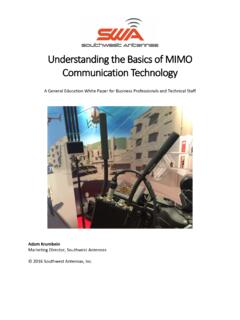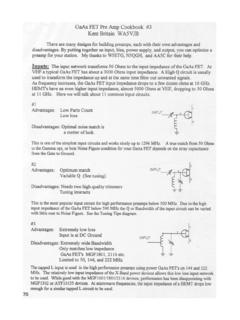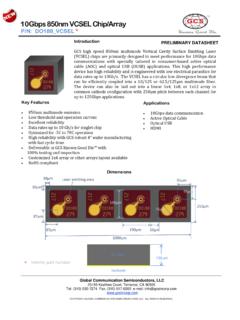Transcription of GaAs MMIC Space Qualification - RFMW Ltd.
1 gaas MMIC SpaceQualificationGaAs MMIC TestingTriQuint Semiconductor has advanced Lot Acceptance Testing (LAT) for HighReliability Applications of gaas MMICs. A flowchart depicting the entireMMIC processing flow, including the Quality Conformance Inspection(QCI)/LAT process described herein and wafer-level lot acceptance testing isprovided on page 3. The requirements for Standard Product Space Qualificationare summarized in table form in Table Engineering (NRE)A packaged assembly will be developed and characterized to verify stability of thedevice, as well as to ensure a high assembly yield for the Qualification DevicesUnder Test (DUTs). The junction temperature will be modeled for each devicetype, considering the device power dissipation and the packaged assembly thermalperformance. Also, additional test fixtures are designed and built at this time.
2 Allrequired test procedures and associated documentation will be FLOWThe QCI uses randomly selected MMICs from the wafer-lot to be qualified,assembled into a package. The assembly processes are mature, documented, andare performed by certified operators in environmentally controlledmicroelectronics assembly MMIC is attached with an eutectic AuSn preform to the package carrierplate using a vacuum reflow process. The off-chip components and TFNs areattached with either eutectic solder or conductive epoxy, depending on the testfixture design. High power dissipation assemblies are then inspected for voidingbeneath the FET areas using X-ray. The carrier plate assemblies are temperaturecycled ten times according to MIL-STD-883, Method 1010, Condition C. Eachassembly is visually inspected to MIL-STD-883, Method 2010, Condition B at80X MMIC TestingS-parameters and device currents are checked on the completed assemblies toscreen for assembly defects.
3 This initial RF test serves as the performancebaseline prior to the burn-in step. For the burn-in and life test, ten DUTs arerandomly designated as QCI DUTs from the population that passes the initial RFtest. Also, three additional devices are selected as archive/calibration devices will not be subjected to burn-in. These reference devices will beused to verify the calibration and setup of each test stage. The QCI DUTs are thensubjected to a 240-hour burn-in is conducted under DC bias only, at a baseplate temperature that willresult in a predetermined channel temperature for the the first burn-in, S-parameters and device currents are again failure criteria is: A +/-10% change in device operating current for amplifiers and mixers, A maximum of 100 uA of leakage current for phase shifters andattenuators And/or a +/-1 dB change in gain from the prior electrical test on any ofthe test QCI DUTs are then subjected to a 1000-hour, steady-state life test under thesame DC bias as the first burn-in.
4 Following the steady-state life test, S-parameters and currents are again measured. The failure criteria is the same as thatused for the conditioning burn-in as described above. Note that the deltaparameters at the 1000 hr point are taken from the 2nd electrical test not the initialelectrical from the QCI process is summarized in a report for the customer. All S-parameter data is archived on disk at TriQuint. The DUTs are also archived LAT data and probe data are deliverable at the time of die shipment, andQCI data is typically delivered 16 weeks after delivery of die. The customer maydecide to wait for completion of QCI test before accepting shipment of Space Qualification FLOWCHARTW afer Fabrication100% Class S VisualInspection MIL-STD-883, Method 2010,Condition AQCI Testing10 Devices per LotWafer-Level LAT (WLAT)Fixture SamplesAssembly screensDC and RF tests240-hour burn-inDC and RF tests1000-hr life testDC and RF testsBond pull testingBackside bond pulltestingLot Process Monitorevaluation100% DC Probe with OptionalRF Probe or sample RFfixture testIn an effort to support customer need for quick-turn Space level devices, severalstandard products are available for purchase as off-the-shelf Space -qualifieddevices (subject to current inventory).
5 These products are listed in the Table 1 andin all cases the NRE required for Qualification has been previously completed. Inaddition, any of our other standard products or devices produced with our Foundrywafer processes can be Space use qualified. For additional information on thesedevices, visit the TriQuint website at 1. Space Qualified Standard ProductsApplicationFunctionDeviceFrequen cy (GHz) DescriptionProcessPower AmpTGA80146 - 18 Power MESFETTGA83342 - 20 Power MESFETTGA250213 - 15 Power PHEMT - PHEMT 2 MITGA907023 - 29 Power PHEMT 2 MITGA450524 - 31 Power PHEMT 2 MITGA9088A6 - 18 Power PHEMT 2 MIDriver AmpTGA8399C6 - 13 Driver PHEMT 2 MITGA250712 - 18 Driver PHEMT 3 MIGain BlockTGA83002 - 18 Gain MESFETTGA86222 - 20 Gain MESFETTGA88102 - 10 Gain MESFETTGA63452 - 18 Gain MESFETTGA4832DC - 35 Wideband PWR-PHEMT 3 MILNATGA83102 - MESFETTGA83442 - MESFETTGA8349DC - MESFETTGA8399B6 - PHEMT 2 MITGA13422 - MESFETTGA450620 - LN-PHEMT - 18 Digital MESFETTGL87842 - 20 Analog MESFETTGL4203DC - 50 Analog PHEMT 3 MITGS8250DC - 18 SPDT MESFETTGS8422DC - 18SP4T MESFETD iscreteTGF4350DC - PHEMT 2 MIOther Experience NumerousDC - 40 PHEMT 2MI &
6 PHEMT 2 MIPhase PHEMT 3 MIPhase PHEMT 2 MIPin Diode 2. Standard Space Qualification FlowTESTCONDITIONSSAMPLEE lement Visual InspectionMIL-STD-883, Method 2010, Condition METAL, GATE METAL,GLASSIVATION, BACKSIDEMETALLIZATION ANDWAFER THICKNESSMEASUREMENTSLot Process Monitor Engineering Data- FIRSTMETAL thickness, GATE METAL thickness,GLASSIVATION thickness, BACKSIDE METAL thickness, WAFER Bond Evaluation/ Bond PullMIL-STD-883, Method 201110 (0) wiresper wafer or 20(1) wires perwaferBackside Metallization/Bond Pull1 mil gold wirebonds bonded to the backside of thedie in two corners, no further than 5 mils from eitheredge. Wires will be pulled to destruction, with a 3gfailure strength from MIL-STD-883, Method 2011,Condition (0) or20 (1)per waferInternal Visual(Fixtured QCI Samples)Temperature CyclingPre-Burn In Electrical(+25 C)Burn InPost Burn In Electrical(+25 C)Steady State LifePost Life Electrical(+25 C)MIL-STD-883, Method 2010, Condition B at 80x10 Cycles, -65 C TO +150 C, 15 Minute hours min, Ta = +125 C min*Spec: S21 of +/- 1 dB from Pre-Burn in Electrical1000 hours min, Ta = +125 C min*Spec: S21 of +/- 1 dB from Post burn-in electrical10 (0) per lot10 (0) per lot10 (0) per lot10 (0) per lot10 (0) per lot10 (0) per lot10 (0) per lotDELIVERABLE DATA:Wafer LAT ReportElement Evaluation/QCI DataProcess Monitor Data, Bond Pull Data, BacksideBond Pull Data.
7 Traveler and Test Data from QCI test.*Ta may be adjusted such that Tj does not exceed 150 C.

![2009-쌍신-교정용-090209 [호환 모드] - RFMW Ltd.](/cache/preview/3/7/7/e/4/c/2/c/thumb-377e4c2c8005e43e87feaf6d98233c6a.jpg)












